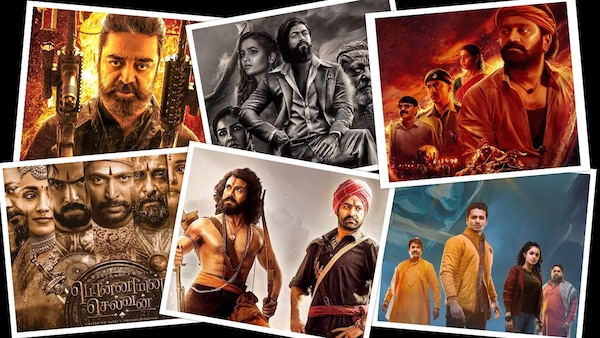Best of 2022: With RRR, Vikram, KGF2 and Kantara, South Indian cinema reinstated its box-office pull on a national level
A bulk of these films relied on strong word-of-mouth to draw crowds to theatres, triumphing past barriers of language, star power minus any bombastic promotional campaigns

Last Updated: 06.53 PM, Dec 18, 2022
Most press interactions in Mumbai this year weren’t complete without one staple question from the press - ‘Bollywood Vs South Indian Cinema’. Year after year, Tamil, Telugu, Kannada, and Malayalam industries came to be identified as regional cinema, while Bollywood postured itself as the poster boy of the Indian film industry across the globe. 2022 sent a strong statement that this trend had to change for good.
If Baahubali and KGF laid the foundation for South Indian cinema to reinstate its identity on a national level, it was in 2022 that the industries spread their wings in and beyond India, like never before. Going by the box office, Kannada, Tamil and Telugu films succeeded in capturing the restlessness of the nation that was on the recovery path post the COVID-19 blues in 2020 and 2021.
The performance of Allu Arjun’s Pushpa The Rise in January over films like 83 was a clear indicator of the change in viewing patterns. Pushpa Raj belonged to a marginalised community, fashionably broke the rules, challenged the system and chased his dreams with a vengeance that offered escapist pleasure to crowds from various walks of life.
This anger, if not consciously, set the tone for most pan-Indian hits in 2022. SS Rajamouli’s RRR, where two real-life warriors took on the British in a fictional setup in the 1920s, was a glimmer of hope for the Indian film industry. The historical drama starring Jr NTR, Ram Charan, Alia Bhatt and Ajay Devgn was the cinematic event that the country desperately needed to bring back crowds to theatres in huge numbers.
The Rs 1200 crore box office collections don’t do justice in describing the cultural impact of RRR. While the film was predominantly catered to the tastes of Telugu audiences, the stubborn conviction with which Rajamouli interspersed music, dance and action with a heavy dose of emotion and patriotism made it an irresistible commercial cocktail with a global appeal.
The other phenomenal success story of the year, Prashanth Neel’s Kannada film KGF 2 wasn’t trying to be an advertisement of high-quality art. It gave Indian viewers a taste of the Amitabh Bachchan era from the 1970s with glossy packaging that gave a fashionable twist to crime. The pronounced mother-son emotion, the catchy dialoguebaazi, the thumping background score composed like a celebration and the breathless edits that didn’t give any time to process the plot - the Yash starrer offered a mainstream concoction that viewers didn’t know they needed.
While RRR, Pushpa and KGF2 featured stars who were in the prime phase of their careers, Vikram had a 68-year-old Kamal Haasan reinventing himself and proving he’s the boss yet again. Surrendering to the vision of a fanboy director Lokesh Kanagaraj, Kamal, the star, took over the performer in him in a violent spectacle of a film that celebrated gore, redemption with technical finesse and redefined the idea of action in Tamil cinema.
Though many believed Vikram wasn’t Kamal’s best, they agreed that he, more than any other star, deserved that scale of commercial success. The mystical thriller Karthikeya 2, directed by Chandoo Mondeti, that made merry at the ticket window across languages, was another surprise pan-Indian hit that not many foresaw. Through a Dan Brown-styled adventure tale set in Dwaraka, the Telugu film was a plea to acknowledge Krishna as a historical hero than a mythological one.
In an era when nationalism and Hindutva are the catchphrases of the hour, Karthikeya 2’s release timing couldn’t have been better. With a smartly written screenplay that mixed mythology with a bunch of conspiracy theories, the narrative didn’t compel the viewers to think beyond the surface and reflected the mood of the nation. The makers of the Nikhil Siddhartha, Anupama Parameswaran starrer knew the audiences they were reaching out to and the rest, as they say, is history.
However, if there was one film that shook the nation without prior warning, it was Rishab Shetty’s Kantara. While it was initially meant to be a Kannada film made for a niche audience, the soaring popularity of the tale (about a tribal group’s fight for their identity) with every passing day forced the makers to dub it in Telugu, Hindi, Malayalam and Tamil languages. There can’t be a better film than Kantara to prove how rooted films, when made with earnestness, can strike a chord with audiences beyond one’s milieu, language or culture.
Mani Ratnam’s Ponniyin Selvan was instrumental in bringing back family crowds to theatres in Tamil Nadu. Generations in the state grew up on Kalki Krishnamurthy’s five-part historical novel and the scale at which the film was made with a dream star cast and a top-notch technical team, prompted viewers to catch it on the big screen. This is another case where the filmmaker stuck to making a film for his core audience and the result didn’t disappoint him. The film tasted limited success beyond its Tamil version, but it managed to be a highly profitable venture for the producers on the whole.
Major, the Sandeep Unnikrishnan biopic starring Adivi Sesh (Hindi-Telugu bilingual), Dulquer Salman-Mrunal Thakur’s Sita Ramam (Telugu), Rakshit Shetty’s 777 Charlie (Kannada) made their mark at the box office across languages and on OTT later. A few widely-marketed biggies from the South faced rejection as well – Vijay Deverakonda’s Liger and Prabhas’ Radhe Shyam being the most prominent among them all. The modest response to Sudeep’s Vikrant Rona wasn’t anticipated either.
If the other industries in the South made noise for their box office returns, Malayalam cinema continued to be revered on OTT for its writing and realistic treatment. Films like Hridayam, Thallumaala, Jana Gana Mana, Bheeshma Parvam, Rorschach, Bro Daddy and Malayankunju earned their due from streaming enthusiasts.
The elephant in the room while discussing the popularity of South Indian Cinema is the absence of well-written female characters with agency and identity. There’s a problem with how Pushpa, RRR, Vikram, Kantara and KGF 2 treated its women. If Rashmika in Pushpa was nothing beyond the romantic interest of Allu Arjun, Alia Bhatt’s impact in RRR was extremely restrictive. Vikram was too obsessed with its men to offer any concrete roles for women and the portrayal of Sapthami Gowda in Kantara wasn’t in great taste either.
The inclusivity that South Indian cinema is experiencing across the country is indeed a heartwarming sign, but filmmakers shouldn’t get distracted by their growing audience base or try too hard to decode the ways of the trade. The beauty and the enigma of cinema is its ever-changing nature. The best one could do is to make a film for the right reasons and tell a darn good story.

